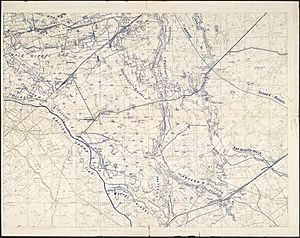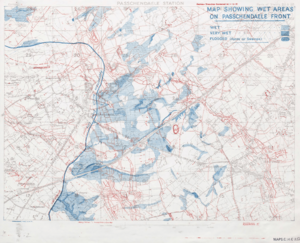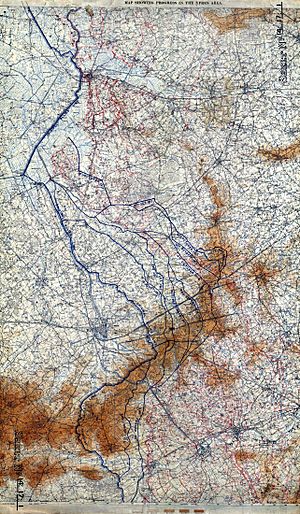Action of 22 October 1917 facts for kids
Quick facts for kids Action of 22 October 1917 |
|||||||
|---|---|---|---|---|---|---|---|
| Part of the Third Battle of Ypres of the First World War | |||||||
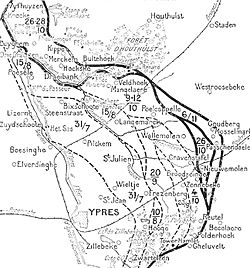 Front line 22 October – 6 November |
|||||||
|
|||||||
| Belligerents | |||||||
| Commanders and leaders | |||||||
| Douglas Haig | Crown Prince Rupprecht | ||||||
| Units involved | |||||||
| Fifth Army French First Army |
4th Army | ||||||
| Strength | |||||||
| 3 British divisions 1 French regiment |
|||||||
| Casualties and losses | |||||||
| British: 479 | 125 POW | ||||||
The action of 22 October 1917 was a battle during the Third Battle of Ypres in World War I. It involved the British Fifth Army and the French First Army fighting against the German 4th Army. Earlier British attacks at Passchendaele had been stopped by the German 4th Army. These included the Battle of Poelcappelle (9 October) and the First Battle of Passchendaele (12 October).
While the British waited for better weather and to build roads, fresh troops arrived. The Canadian Corps and new British divisions were sent to Flanders. The Fifth Army planned to capture the rest of Poelcappelle. They also wanted to get closer to Houthulst Forest. The French army on the left attacked at the same time. This attack aimed to protect the British Second Army. It also kept pressure on the German defenders. This was important to stop Germany from moving troops away from Flanders. It also prevented them from focusing their artillery on the Canadians. The Canadians were preparing for their own attack on 26 October.
On 22 October, the 18th (Eastern) Division attacked Poelcappelle. The 34th Division attacked further north. The 35th Division moved north into Houthulst Forest. A French regiment supported this attack. Poelcappelle was captured. However, the attack between the 34th and 35th divisions failed. German counter-attacks pushed back the 35th Division. The French troops reached their goals. They later explored Houthoulst Forest and captured river crossings.
The ground was very muddy and damaged by bombs. This made it hard for the British to advance quickly. They could not easily go around German strongholds called pillboxes. Troops from the 35th Division reached the edge of Houthulst Forest but were pushed back elsewhere. German counter-attacks after 22 October also faced the same difficult conditions. These attacks also failed with heavy losses. The battle stopped the German 4th Army from moving troops. It also prevented them from focusing their artillery on the Canadians. This helped the Canadians prepare for the Second Battle of Passchendaele (26 October – 10 November 1917).
Background to the Battle
Strategic Planning for the Offensive
At a meeting on 13 October, British commanders made a decision. They agreed that no more attacks could happen until the rain stopped. They also needed to build roads to move artillery forward. This would make their bombardments more effective. General Haig wanted to continue the attack. His goal was to capture Passchendaele Ridge. This would also help the French attack at La Malmaison. It would keep German troops busy in Flanders.
Haig also mentioned an attack by the Third Army at Cambrai. This attack was planned for before winter. The Third Army commander wanted operations to continue in Flanders. This would increase the chances of success at Cambrai. Even though the ground in the Ypres Salient was terrible, the attack would continue.
Officers flew over the battlefield to check the ground. The Fifth Army would get two new divisions for the attack on 22 October. One part of the army, XVIII Corps, would capture the rest of Poelcappelle. Another part, XIV Corps, would attack north into Houthulst Forest. This would move the British line to higher ground. The French First Army would protect the left side of XIV Corps. They would attack Houthulst Forest with two divisions.
British Attack Methods in 1917
After the Battle of the Menin Road Ridge on 20 September, British attack plans became very organized. Orders were almost like a formula. Commanders had more freedom to make decisions than in earlier years. The British army became more skilled during the battle. However, it was still hard to communicate between the front lines and the rear.
German defenses often used strong concrete bunkers called pillboxes. The ground was also full of flooded shell-holes. This made it impossible for soldiers to stay in straight lines. So, waves of infantry were replaced by small groups of skirmishers. The rifle became the main weapon again. Mortar fire was added to the "creeping barrages." A creeping barrage was a moving wall of artillery fire that advanced ahead of the infantry. "Draw net" barrages were also used. Here, field guns would fire behind German lines, then move forward, then back again several times.
German Defensive Strategies
Erich Ludendorff, a top German general, changed German defense plans. This happened after the difficult Battle of Broodseinde on 4 October. Ludendorff insisted on a new "outpost line" in front of the main defense. This area, about 500 to 1,000 yards deep, would have only a few sentries and machine-guns. When the British attacked, these sentries would quickly retreat. The artillery would then bombard the outpost line. This tactic aimed to give German reserve troops time to reach the main defense line.
If an immediate counter-attack was not possible, a planned counter-attack would happen later. This would be after 24 to 48 hours. This time was used to prepare artillery, infantry, and aircraft. German divisions held wide fronts, but the constant British shelling caused many casualties. Divisions had to be replaced more often. Shell-holes were used as cover instead of trenches.
The German commander, Armin, ordered these new tactics on 11 October. He noted that if British attacks were small, German divisions could stop them. But if attacks succeeded, even fresh divisions struggled to get back lost ground. Armin stressed that front-line divisions needed enough soldiers. He also said that counter-attack divisions should be used carefully. After a battle, front-line troops were often exhausted. They needed to be replaced by fresh units.
First Battle of Passchendaele Outcome
On 12 October, the German defense was stronger than the British expected. Even with new tactics, the Germans lost some ground. The main British attack on Passchendaele village failed with heavy losses. The area north of Broodseinde to Houthulst Forest was covered with dead and wounded soldiers. The German divisions that fought on 9 October did not need to be replaced before the 12 October attack. The British Fifth Army had almost 10,000 casualties from 9 to 14 October.
The German army command thought the Allied advance in the north was less dangerous. They were more worried about the advance towards their main defensive position. Ludendorff changed his mind about holding Passchendaele Ridge. He believed the British only had two weeks before autumn weather ended the battle. So, he ordered his troops to hold their ground.
Preparing for the Attack
German Defensive Preparations
On several nights in mid-October, the Germans used gas attacks. They fired "Blue Cross" gas shells first. This gas made soldiers take off their gas masks. Then, "Yellow Cross" mustard gas shells followed. This gas caused blisters and injuries to the throat and eyes. Few Allied soldiers died, but thousands were affected. They needed medical treatment.
German troops were constantly moving into the area. They were often under British and French artillery and gas attacks. On 20 October, Allied shelling shifted to German support lines. The next day, German artillery fired back. This was to disrupt British and French troops gathering for the attack.
British Offensive Preparations
| Date | Rain mm |
°F | |
|---|---|---|---|
| 13 | 10.7 | 52 | dull |
| 14 | 0.0 | 52 | dull |
| 15 | 0.0 | 52 | fog |
| 16 | 0.1 | 54 | fine |
| 17 | 7.1 | 56 | fine |
| 18 | 0.0 | 58 | — |
| 19 | 2.9 | 48 | dull |
| 20 | 0.0 | 48 | dull |
| 21 | 1.3 | 54 | — |
| 22 | 3.2 | 56 | dull |
| 23 | 4.0 | 50 | — |
The weather improved in mid-October. Less rain fell, which stopped the ground from getting worse. German artillery increased its shelling on British roads and preparations. These were easy to see from Passchendaele Ridge. From 14 October, Germans shelled the Steenbeek Valley almost every night with gas. German planes also bombed targets behind Allied lines. British artillery positions were covered in mustard gas and had to be quarantined.
Despite the gas and shelling, new roads and artillery spots were built on time. From 21 October, British artillery began cutting German wire. They also destroyed German pillboxes and blockhouses. Daily bombardments were fired deeper into German defenses.
XVIII Corps Preparations
After the First Battle of Passchendaele (12 October), Poelcappelle was mostly destroyed. The road from Langemarck had almost disappeared. Moving to the front line meant walking 5 miles on duckboard tracks. These were wooden paths over the mud. German shelling often interrupted movement. On 12 October, a British brigade attacked Poelcappelle. They were pushed back because their weapons jammed with mud. It rained again on the night of 12/13 October. Some units did not get food for two days.
XIV Corps Preparations
The 34th Division took over from another division on the night of 12/13 October. It was a two-hour walk through mud, destroyed equipment, and bodies. Duckboards reached within 1,000 to 1,500 yards of the front line. Two battalions were bombed on the night of 16/17 October. They lost 106 soldiers. The division took over more front line areas. On 20 October, two battalions of the Royal Scots relieved another brigade. Both commanding officers suffered from gas poisoning.
The 104th Brigade of the 35th Division took over from another brigade on 16 October. Movement to the front line was difficult. German artillery filled the shell-holes with high explosive and gas shells most nights. A light railway was built to carry ammunition and supplies. The area was so waterlogged that many German shells did not explode. On 21 October, British artillery shelled German positions all day. The Germans fired back. A German soldier was captured, which made the British think the Germans had been reinforced. The night of 21/22 October was very cold. It started to rain at midnight and continued on and off all day.
Air Operations
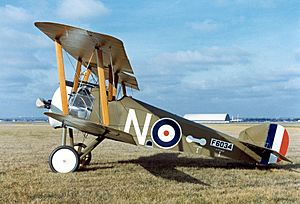
In the better weather before 22 October, the Royal Flying Corps (RFC) flew many missions. They scouted the area and helped direct artillery fire. On 20 October, 45 aircraft attacked a German airfield. Sopwith Camels dropped bombs and then fired machine guns at the airfield. Other planes provided cover. The British claimed to have shot down seven German aircraft. As the Camels flew home, they attacked other targets.
On the night of 20/21 October, British bombers attacked German railway stations and airfields. On 21 October, reconnaissance planes took 1,304 photographs. Artillery crews directed bombardments on 67 German artillery batteries. Bombing raids were made on other airfields. In dogfights with German fighters, ten German planes were claimed shot down. The British lost 19 aircrew. During the night, British bombers attacked more German airfields and a railway station.
British Attack Plan
The British Second and Fifth armies' artillery would open fire at the start of the attack. This was to trick the Germans about the limited size of the Fifth Army's attack. In Poelcappelle, the space between the two armies was very narrow. So, British troops had to pull back temporarily for their artillery to shell the area.
The 18th (Eastern) Division would attack with one brigade. One battalion would capture an early objective. A second battalion would take the final objective. The attack had three phases. In the first phase, three companies of the 8th Battalion, Norfolk Regiment would advance into the village. They would capture German pillboxes at the Brewery. Another company would attack pillboxes near Helles Houses. After a two-hour break, the second phase would begin. Three companies of the 10th Battalion Essex Regiment would move through the Norfolk positions. They would follow a creeping barrage to the final objectives. If this succeeded, the third phase would start. The fourth Essex company would capture another blockhouse.
The 34th Division would attack on a 2,000-yard front. This was from Poelcappelle to the Ypres–Staden railway. One brigade would attack on the right side. Two battalions of another brigade would attack north of a stream. On 21 October, British artillery hit positions north of the stream. This caused 80 casualties. Two battalions had to gather 200 yards behind the front line. This was difficult at night and under fire. The attack would pivot on the right side. The left side would swing forward to a crossroads, connecting with the 35th Division.
On the left side, the 35th Division would attack 800 yards into Houthulst Forest. The objective was about 2,500 yards wide. This required a spreading advance. One brigade would attack on the right with two battalions. Another brigade would attack on the left with two battalions. The Canadian Corps would support the attack. They would use gas shells on German artillery. They would also use gas shells on German shell-hole positions. A feint (fake attack) would also be made to help the 18th (Eastern) Division.
The French XXXVI Corps would protect the left side of the British XIV Corps. A French infantry regiment would advance northwards. They would capture several strongholds. The preliminary bombardment was very effective. The French quickly took their objectives. They also helped the British destroy some pillboxes. In the afternoon, French patrols reached the edge of Houthulst Forest. They captured two field guns and several prisoners.
The Attack Begins
Fighting at Poelcappelle
The attacking troops moved to the front line on the night of 21/22 October. They walked through the muddy Steenbeek area. They had already been shelled with high explosive and gas. The 8th Norfolk Regiment was in position by 1:00 a.m. when it started to rain. The 10th Essex Regiment was ready by 2:00 a.m. The British artillery barrage began at 5:35 a.m. Eight minutes later, it started to move forward.
The 8th Norfolk advanced through the village. They met little resistance and captured the pillboxes at the Brewery. One hour later, the 10th Essex advanced. A machine-gun stopped part of their advance. But a group went around and captured the machine-gun post. The Essex then moved to the Norfolk positions. They found cover in the village ruins and shell-holes. German artillery fire increased. The muddy ground made it hard to move out of the shelled area. One company of the Essex Regiment arrived at the starting point with many fewer soldiers. Their weapons were already jammed with mud.
At 7:35 a.m., the barrage moved forward again. The 10th Essex companies moved past the 8th Norfolk. They faced little machine-gun fire but constant German artillery. One company was so small it only attacked Meunier House. The German soldiers retreated before the British arrived. In the center, another company captured its objective. A third company took Nobles Farm. By 8:00 a.m., the troops were digging in. But two companies were down to only 80 men. Most of their machine-gun ammunition was used. Weapons were still clogged with mud.
Troops from another regiment moved forward to Meunier House at 10:00 a.m. Others took over at Nobles Farm. On the right side, a company attacked at 8:35 a.m. They faced heavy artillery fire but little infantry resistance. By 9:00 a.m., the company was setting up posts in flooded shell-holes. A patrol went forward to Tracas Farm, which was empty. At 4:30 p.m., the German shelling increased. German infantry began to move forward. They advanced slowly from shell-hole to shell-hole. But they were stopped by the small-arms fire of the 10th Essex.
Pushing into Houthulst Forest
34th Division's Advance
At 5:35 a.m., the British barrage began. It seemed strong and accurate. In the 34th Division's area, one battalion captured Requette Farm. The rest of the battalion moved towards Rubens Farm. The 15th Royal Scots advanced towards their first objective. This was near huts along a road and a stream. Two support companies waited further back. The attacking battalions were hit by machine-gun fire from several directions. This was especially from pillboxes on the north bank of the stream.
German artillery fire began after ten minutes. Only a few shells landed near the attackers. But one farm was hit accurately. Half of the two support companies could not move forward. As one company neared its objective, machine-gun fire from pillboxes became very strong. These pillboxes were surrounded by uncut barbed wire. The surviving soldiers struggled through the mud. They were forced to take cover in shell-holes. Attempts to cut the wire and attack the positions failed.
The 16th Royal Scots were hit by artillery from both sides as they gathered. They only had enough men for one wave of attack. The troops on the right side were caught in machine-gun fire. They lost much of their firepower as weapons jammed with mud. They were forced back by a German counter-attack. On the left side, two companies reached some pillboxes. The advance was stopped by machine-gun fire. The troops fired back to help another British battalion. This battalion tried to go around the pillboxes. This attempt also failed due to uncut wire. But a group of Royal Scots captured a pillbox and six prisoners.
At 7:00 a.m., a German counter-attack was stopped by rifle fire. But after holding on with many casualties, the remaining Royal Scots retreated. Communication with the rear was almost impossible. Telephone cables were cut early. Runners were slowed by the mud. The area was shelled continuously all day. During the night, two fresh battalions relieved the attacking battalions.
35th Division's Efforts
The 104th Brigade battalions moved forward at 2:00 a.m. This was to avoid the German dawn bombardment. The advance began at 5:35 a.m. behind a creeping barrage. The 23rd Manchester battalion on the right lost contact with the 34th Division. This was because they had pulled back to avoid shelling. The advance continued for about half a mile to the first objective. Machine-gun fire came from huts on both sides. Almost all but fifty men of the leading waves became casualties. The survivors slowly retreated to the starting line.
On the left, the 17th Lancashire Fusiliers followed the barrage along a road. They reached Colombo House. By 6:45 a.m., they had reached the final objective. Another company was supposed to fill a gap. But it went to the left side, causing a delay. The company advanced into Houthulst Forest. But it was fired on by machine-guns on the right side. This side was not supported, so they had to retreat to the edge of the woods. Other troops reached their objective along Conter Drive. This road ran through Houthulst Forest. By noon, the brigade held a line from Maréchal Farm.
The 105th Brigade troops formed up with support companies in the front line. The attacking companies were further back in shell-holes. The advance began behind the creeping barrage. But bad ground immediately slowed them down. On the right, the 16th Cheshire advanced faster. They reached the objective at Maréchal Farm. But the advance in the center and on the left was stopped by machine-guns in pillboxes. These were inside the forest. The pillboxes were captured. But the advance stopped again just beyond. The troops dug in.
French 1st Division's Role
The German 40th Division and parts of the 58th Division held the line against the French. The 201st Infantry Regiment of the French 1st Division was to advance. They were to capture several strongholds. The initial bombardment was very effective. The French quickly took their objectives. This was despite machine-gun fire from a farm on the left. The French joined the British attack. They helped to reduce a number of pillboxes. Resistance was met at Panama Farm, but it was soon overcome.
In the afternoon, patrols reached the edge of Houthulst Forest. They were often up to their waists in water. They captured two field guns and several prisoners. Two reserve regiments of the 1st Division sent groups forward. They captured crossings along a stream on the left. A British platoon helped with communication. When the French reached their objectives, their commander sent two companies. They formed a defensive line.
German Counter-attacks
After a quiet period, German troops attacked. This was on the left side of the 16th Cheshire. They overran the British defenses. The survivors were almost surrounded. They retreated about 100 yards from Houthulst Forest. But then they were pushed back to the starting line. This retreat left the left side of the Maréchal Farm group exposed. They formed a defensive line along the road back to Colombo House.
As the left side of the Cheshires moved back, another British company also retreated. They thought they were being left exposed. This retreat left another company isolated. It withdrew to Colombo House. After the German counter-attack and confusion, only one British battalion remained on the final objective. In this area, the German attack was caught in a British barrage and was stopped.
The 14th Gloucester angled its right side backward. This was to connect with the 16th Cheshire. Another group filled the gap. As the German counter-attack continued, troops gathered. They attacked the 17th and 18th Lancashire. The British called for an SOS bombardment. When the Germans attacked, they were pushed back with many casualties. It became much harder to communicate with the rear. German shelling was constant behind the British front line. Units started to mix together. The attacking battalions became tired. The weather got worse, making movement even harder. Despite this, groups brought tea and rum to the front line troops. The German counter-attacks ended.
October 23–24 Actions
Machine-gun nests were blamed for the failure of the attack. At 2:00 a.m. on 23 October, a group of 22 men struggled through the mud. They reached a position 350 yards beyond the wire. This wire had stopped the British advance the day before. The group surprised a machine-gun post. But the noise alerted the Germans. They sent up flares and shelled the area. This caused many casualties as the raiding party retreated.
At 5:30 a.m., a German counter-attack began on the left side. This was at the meeting point of a British brigade and a French regiment. It was stopped by small-arms fire and an SOS barrage. About twenty prisoners were taken. It was thought that many more German soldiers were shot before they could surrender. The British infantry fired shrapnel over shell-holes. Many German troops had taken cover there. At least forty men were killed.
On the night of 23/24 October, the 15th Cheshire returned to the first objective. They advanced 200 yards north of Colombo House. This filled in part of the gap caused by British retreats. At 5:00 p.m., another German counter-attack began. About 300-400 German infantry advanced behind a creeping barrage. But the attack was stopped by small-arms fire and artillery. 60-70 Germans were killed, and several prisoners were taken.
Air Support During the Attack
The attack on 22 October happened during a rainstorm. This kept many RFC aircraft on the ground until the afternoon. But British infantry advances were seen by contact-patrol aircraft crews. Especially in the afternoon and evening, fighter pilots attacked German troops. Machine-gun nests and artillery batteries were also attacked. Two battalions of infantry moving along a road were caught by two Camel pilots and scattered. A bomber squadron attacked a village where many soldiers were resting.
German aircraft flew at low altitude. They attacked the positions of the 35th Division. One German aircraft followed a British contact-patrol aircraft. When British troops responded to a call for flares, the German pilot dropped signal lights on them. This marked their position for German artillery. The British sent an anti-aircraft gun forward. It was to engage German aircraft but had little effect.
Aftermath of the Action
Casualties from the Battle
The Fifth Army had 60 men killed on 22 October. They also had 398 wounded and 21 missing. Approximately 125 German soldiers were captured. The 34th Division spent sixteen days in the line during October. They had 303 men killed, 1,089 wounded, and 405 missing. From 10 to 27 October, 886 men were evacuated due to sickness. From 18 to 29 October, the 35th Division had 368 men killed, 1,734 wounded, and 462 missing. The 35th divisional artillery lost 27 men killed, 165 wounded, and 2 missing. 85 prisoners were taken from 18 to 25 October.
Next Steps in the War
After 23 October, the French prepared for their next operation. They planned to occupy all the ground from Houthoulst Forest to Blankaart Lake. This would happen as the British advanced to Passchendaele. On 26 October, the British XVIII Corps attacked German defenses. This was to support the Canadian Corps. The divisions attacked towards Westrozebeke. But deep mud slowed the advance to a crawl. The creeping barrage moved too fast. Rifles clogged with mud. The British fell back to their starting line or were surrounded. The XIV Corps also attacked. But the ground was in terrible condition. On the left, the French 1st Division managed a short advance into Houthulst Forest. These attacks cost the Fifth Army 5,402 casualties.
See Also
- Second Battle of Passchendaele
Images for kids


